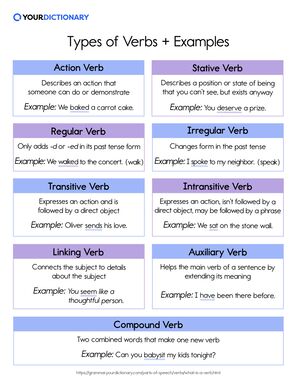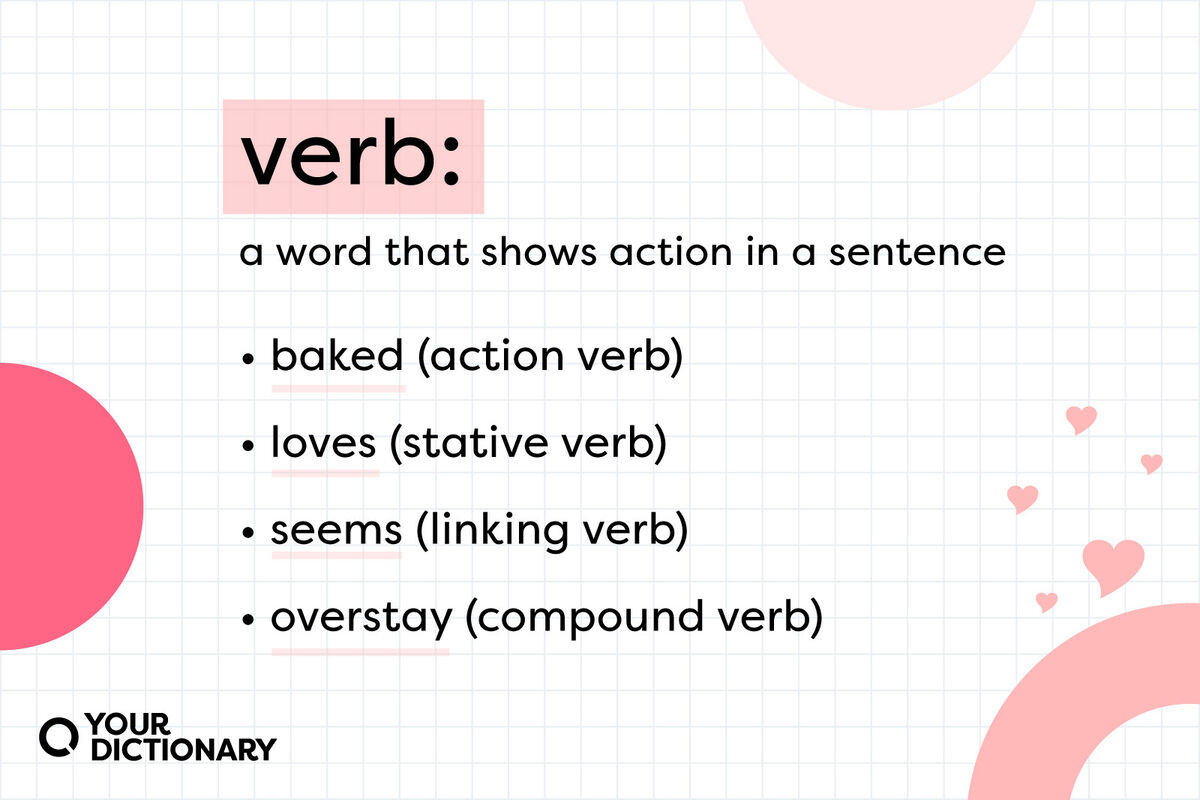

Jumping, eating, sneezing, and sleeping are all verbs you likely perform in a single day, though hopefully not at the same time (that could get messy). While most verbs show the action in a sentence, some verbs are a little harder to spot. However, every sentence needs one — or it’s not a sentence at all.
What Is a Verb?
Verbs are words that show action in a sentence. Just like nouns and adjectives, they’re one of the eight parts of speech.
Verbs also show:
- the tense (time period) of a sentence
- agreement with the subject of a sentence
- a noun’s state of being
- more information about a noun
A printable chart of the nine types of verbs can help you keep them and their functions straight.

Examples of Verbs in a Sentence
Verbs are the first part of a sentence predicate, and often the first word after a noun or pronoun. For example:
- Bob walked down the street.
- I love that movie.
- We sang all night.
- The family drove to the mountains.
The 9 Types of Verbs
With all the jobs verbs have, it’s not surprising that there is more than one type. In fact, there are nine types of verbs — and understanding them can help you make your writing more interesting.
1. Action Verbs
Action verbs describe actions that someone can do or demonstrate. Most verbs are action verbs. Typically, action verbs follow nouns or pronouns in a sentence.
Examples of action verbs include:
- Naomi accepted the job offer.
- We baked a carrot cake.
- She ironed her dress.
- Mark drinks vanilla lattes.
2. Stative Verbs
Stative verbs describe a position or state of being that you can’t see, but exists anyway. While they don't perform any visible action, notice that they're typically followed by a direct object.
- You deserve a prize.
- Jane hates humidity.
- Henry loves billiards.
- I remember you.
3. Regular Verbs
Most verbs are regular verbs — verbs that only add -d or -ed in their past tense form.
- We walked to the concert. (walk becomes walked)
- Pauly lied to his friends. (lie becomes lied)
- The kids performed in the school play. (perform becomes performed)
- I smelled smoke in the hallway. (smell becomes smelled)
4. Irregular Verbs
Verbs that change form in the past tense are irregular verbs.
- I spoke to my neighbor. (speak becomes spoke)
- We saw the new action movie last night. (see becomes saw)
- The community felt nervous. (feel becomes felt)
- Nora made a beautiful speech at the wedding. (make becomes made)
5. Transitive Verbs
Transitive verbs express an action and are followed by a direct object. They “transfer” their action to another noun (underlined). Many transitive verbs don’t make sense without an object.
- Joshua brought the noodles. (Joshua brought doesn’t make sense without noodles)
- Sarah organized the kitchen. (Sarah organized doesn’t make sense without the kitchen.)
- Can I borrow your car? (Can I borrow doesn’t make sense without your car)
- Oliver sends his love. (Oliver sends doesn’t make sense without his love)
6. Intransitive Verbs
Intransitive verbs express an action, but they aren’t followed by an object. However, they can be followed by a phrase.
- Teresa smiled at me. (Teresa smiled makes sense on its own)
- We sat on the stone wall. (We sat makes sense on its own)
- The boat floats in the bathtub. (The boat floats makes sense on its own)
- My sister cried all night. (My sister cried makes sense on its own)
Some verbs (such as clean or read) can take transitive or intransitive meanings, depending on the context in the sentence.
7. Linking Verbs
Linking verbs connect the subject to details about the subject. Various forms of the verb to be are linking verbs, including am, is, are, and were.
Examples of linking verbs include:
- Damien is an expert craftsman.
- We became best friends in high school.
- You seem kind and thoughtful.
- I am taller than my brother.
8. Auxiliary Verbs
Auxiliary verbs, also known as helping verbs, help the main verb of the sentence (known as a participle) by extending its meaning. You’ll see them in verb phrases where one verb doesn’t form a complete thought, or in perfect verb tenses.
- I have been there before.
- Paul doesn’t know his way home.
- He didn’t run for president.
- The dogs are playing in the yard.
Modal verbs are auxiliary verbs that show possibility or necessity. They always accompany other action verbs.
- We will find the perfect pumpkin.
- Tiffany might want another helping of pie.
- I must finish this project tonight.
- The whole team should be there.
9. Compound Verbs
Just like compound nouns combine two words to create a new noun, compound verbs combine two words to create a new verb.
Compound verbs can be one or two words long, or they can be hyphenated.
- Don’t overstay your welcome.
- Can you babysit my kids tonight?
- Be sure to waterproof your new shoes.
- I color-coded my whole file cabinet.
Phrasal verbs are a type of compound verb that end with a preposition. They’re often difficult to directly translate to different languages because they’re English idioms.
- Can you take out the trash?
- My girlfriend just broke up with me.
- Don’t give up on your dreams.
- The kids get along so well.
Take Action and Review Your Verbs
Review and practice are two important verbs that can help you with the rest of your grammar. Work on verbs (and go even further) with several review activities, games, or a quiz on subject verb agreement below.
- Play some action verb games to test your knowledge, as well as some helping verb games.
- Learn how to identify verb mood in grammar and how it’s more important than you think.
- Master irregular verb conjugation to avoid unnecessary grammar mistakes. (Then play some irregular verb games to reinforce your understanding.)
- Find out how strong verbs are different from weak verbs, and whether the difference matters in your writing.